A New Approach for Evaluation True Stress–Strain Curve from Tensile Specimens for DC04 Steel with Vision Measurement in the Post-Necking Phases
Abstract
1. Introduction
1.1. Extensometer Measurement Techniques
1.2. Theory of the Tension Test
1.2.1. Uniform Deformation
1.2.2. Extended Stress–Strain Curve
1.2.3. Evaluation of the Shape of the Sample
2. Materials and Methods
2.1. Vision Extensometer Techniques
2.2. Experimental Procedure
2.3. Image Processing—Thresholding
2.4. VEIP Calibration System
2.5. DIC Technique
3. Results and Discussion
4. Conclusions
Author Contributions
Funding
Data Availability Statement
Conflicts of Interest
References
- Motra, H.B.; Hildebrand, J.; Dimmig-Osburg, A. Assessment of strain measurement techniques to characterise mechanical properties of structural steel. Eng. Sci. Technol. 2014, 17, 260–269. [Google Scholar] [CrossRef]
- Salbut, L.A. Novel laser full-field extensometer integrated with loading machine. In Proceedings of the Optical Diagnostics for Industrial Applications, Glasgow, UK, 22–24 May 2000. [Google Scholar] [CrossRef]
- Buchar, Z. Circle grid analysis applied to the production problems of the car body panel. J. Mater. Process. Technol. 1996, 60, 205–208. [Google Scholar] [CrossRef]
- Bogdanov, A.A.; Panin, S.V.; Lyubutin, P.S.; Eremin, A.V.; Buslovich, D.G.; Byakov, A.V. An Automated Optical Strain Measurement System for Estimating Polymer Degradation under Fatigue Testing. Sensors 2022, 22, 6034. [Google Scholar] [CrossRef] [PubMed]
- Schreier, H.; Orteu, J.J.; Sutton, M.A. Image Correlation for Shape, Motion and Deformation Measurements: Basic Concepts. In Theory and Applications; Springer: Boston, MA, USA, 2009; ISBN 9780387787466. [Google Scholar]
- Pan, B. Recent Progress in Digital Image Correlation. Exp. Mech. 2011, 51, 1223–1235. [Google Scholar] [CrossRef]
- Chen, Y.; Ji, C.; Zhang, C.; Sun, S. The Application of DIC Technique to Evaluate Residual Tensile Strength of Aluminum Alloy Plates with Multi-Site Damage of Collinear and Non-Collinear Cracks. Metals 2019, 9, 118. [Google Scholar] [CrossRef]
- Härtel, M.; Illgen, C.; Frint, P.; Wagner, M.F.X. On the PLC Effect in a Particle Reinforced AA2017 Alloy. Metals 2018, 8, 88. [Google Scholar] [CrossRef]
- Zanuy, C.; Ulzurrun, G.S.D.; Curbach, M. Experimental Determination of Sectional Forces in Impact Tests: Application to Composite RC-HPFRCC Beams. Eng. Struct. 2022, 256, 114004. [Google Scholar] [CrossRef]
- Liu, C.; Chen, Z.; He, X. Application of 3D-DIC in Experimental Study on Mechanical Properties of Civil Structures. J. Southeast Univ. Nat. Sci. Ed. 2014, 44, 339–344. [Google Scholar] [CrossRef]
- Mahal, M.; Blanksvärd, T.; Täljsten, B.; Sas, G. Using Digital Image Correlation to Evaluate Fatigue Behavior of Strengthened Reinforced Concrete Beams. Eng. Struct. 2015, 105, 277–288. [Google Scholar] [CrossRef]
- Yu, Q.-Q.; Wu, Y.-F. Fatigue Strengthening of Cracked Steel Beams with Different Configurations and Materials. J. Compos. Constr. 2017, 21, 04016093. [Google Scholar] [CrossRef]
- Li, D.; Huang, P.; Guo, X.; Zheng, X.; Lin, J.; Chen, Z. Fatigue Crack Propagation Behavior of RC Beams Strengthened with CFRP under Cyclic Bending Loads. Fatigue Fract. Eng. Mater. Struct. 2018, 41, 212–222. [Google Scholar] [CrossRef]
- Barile, C.; Pappalettera, G.; Kannan, V.P.; Casavola, C. A Neural Network Framework for Validating Information–Theoretics Parameters in the Applications of Acoustic Emission Technique for Mechanical Characterization of Materials. Materials 2023, 16, 300. [Google Scholar] [CrossRef]
- Bogusz, P.; Nasiłowska, B.; Sławiński, G. Optical Strain Measurement and Microfractography of the Fractures of Armstal 550 Steel after Temperature Tensile Tests. Materials 2022, 15, 8875. [Google Scholar] [CrossRef] [PubMed]
- Lobanov, M.L.; Khotinov, V.A.; Urtsev, V.N.; Danilov, S.V.; Urtsev, N.V.; Platov, S.I.; Stepanov, S.I. Tensile Deformation and Fracture Behavior of API-5L X70 Line Pipe Steel. Materials 2022, 15, 501. [Google Scholar] [CrossRef] [PubMed]
- Ünlü, A.; Esener, E.; First, M. Evaluation of Plasticity Models Using Uniaxial Tensile Test. Eur. Mech. Sci. 2020, 4, 116–122. [Google Scholar] [CrossRef]
- Becker, B.; Dripke, M. Choosing the Right Extensometer for Every Materials Testing Application. Adv. Mater. Process 2011, 169, 17–21. [Google Scholar]
- Shabestari, N.P. Fabrication of a simple and easy-to-make piezoelectric actuator and its use as phase shifter in digital speckle pattern interferometry. J. Opt. 2019, 48, 272–282. [Google Scholar] [CrossRef]
- Corderoa, R.; Francois, M.; Lira, I.; Vial-Edwards, C. Whole-field analysis of uniaxial tensile tests by Moire interferometry. Opt. Lasers Eng. 2005, 43, 919–936. [Google Scholar] [CrossRef]
- Sirkis, J.S.; Lim, T.J. Displacement and Strain Measurement with Automated Grid Methods. Exp. Mech. 1991, 31, 382–388. [Google Scholar] [CrossRef]
- Khoo, S.W.; Karuppanan, S.; Iskandar, B.S. A Review of Surface Deformation and Strain Measurement Using Two-Dimensional Digital Image Correlation. Metrol. Meas. Syst. 2016, 23, 461–480. [Google Scholar] [CrossRef]
- Hoffmann, H.; Vogl, C. Determination of True Stress-Strain-Curves and Normal Anisotropy in Tensile Tests with Optical Strain Measurement. CIRP Ann. 2003, 52, 217–220. [Google Scholar] [CrossRef]
- Ma, N.; Sato, K.; Takada, K. Analysis of Local Fracture Strain and Damage Limit of Advanced High Strength Steels using Measured Displacement Fields and FEM. Comput. Mater. Contin. 2015, 46, 195–219. [Google Scholar]
- Ludwik, P. Elemente der Technologischen Mechanik; Verlag von Julius Springer: Berlin, Germany, 1909; p. 32. [Google Scholar]
- Swift, H.W. Plastic instability under plane stress. J. Mech. Phys. Solids 1952, 1, 1–18. [Google Scholar] [CrossRef]
- Hollomon, J.H. Tensile deformation. Trans. Metall. Soc. AIME 1945, 162, 268–290. [Google Scholar]
- Hill, R. The Mathematical Theory of Plasticity; Clarendon Press: Oxford, UK, 1950. [Google Scholar]
- Onat, E.T.; Prager, W. The Necking of a Tension Specimen in Plane Plastic Flow. J. Appl. Phys. 1954, 491, 491–493. [Google Scholar] [CrossRef]
- Bridgman, P.W. Studies in Large Plastic Flow and Fracture; McGraw-Hill: New York, NY, USA, 1952. [Google Scholar]
- Siebel, E.; Schwaigere, S. Mechanics of tensile test. Arch Eisenhuttenwes 1948, 19, 145–152. [Google Scholar]
- Davidenkov, N.N.; Spiridonova, N.I. Mechanical methods of testing. Analysis of the state of stress in the neck of a tension test specimen. Proc. Am. Soc. Test Mater. 1947, 46, 1147–1158. [Google Scholar]
- Kaplan, M. The stress and deformation in mild steel during axisymmetric necking. J. Appl. Mech. 1973, 40, 271–276. [Google Scholar] [CrossRef]
- Zhang, Z.L.; Odegard, J.; Sovik, O.P. Determining true stress- strain curve for isotropic and anisotropic materials with rectangular tensile bars: Method and verifications. Comput. Mater. Sci. 2001, 20, 77–85. [Google Scholar] [CrossRef]
- Ling, Y. Uniaxial true stress–strain after necking. AMP J. Technol. 1996, 5, 37–48. [Google Scholar] [CrossRef]
- Siegmann, P.; Alén-Cordero, C.; Sánchez-Montero, R. Experimental approach for the determination of the Bridgman’s necking parameters. Meas. Sci. Technol. 2019, 30, 114003. [Google Scholar] [CrossRef]
- Mirone, G. A new model for the elasto-plastic characterisation and the stress–strain determination on the necking section of a tensile specimen. Int. J. Solids Struct. 2004, 41, 3545–3564. [Google Scholar] [CrossRef]
- Zhang, Z.L.; Hauge, M.; Ødegård, J.; Thaulow, C. Determining material true stress–strain curve from tensile specimens with rectangular cross-section. Int. J. Solids Struct. 1999, 36, 3497–3516. [Google Scholar] [CrossRef]
- Brunet, M.; Morestin, F. Experimental and analytical necking studies of anisotropic sheet metals. J. Mater. Process. Technol. 2001, 112, 214–226. [Google Scholar] [CrossRef]
- Srinivasan, R.; Hartley, C.S.; Raju, B.B.; Clave, J. Measurement of neck development in tensile testing using projection moire. Opt. Eng. 1982, 21, 655–662. [Google Scholar] [CrossRef][Green Version]
- Le Roy, G.; Embury, J.D.; Edwards, G.; Ashby, M.F. A model of ductile fracture based on the nucleation and growth of voids. Acta Metall. 1981, 29, 1509–1522. [Google Scholar] [CrossRef]
- Michiue, N.; Baba, M.; Ohtani, K. A new sensor system for simultaneously detecting the position and incident angle of a light spot. In Proceedings of the SICE 2003 Annual Conference, Fukui, Japan, 4–6 August 2003; Volume 1, pp. 456–460. [Google Scholar] [CrossRef]
- Cao, L.; Shi, Z.K.; Chenp, E.K.W. Fast automatic multilevel thresholding method. Electron. Lett. 2002, 38, 868–870. [Google Scholar] [CrossRef]
- Wong, A.K.C.; Sahoo, P. Gray-level threshold selection method based on maximum entropy principle. IEEE Trans. Syst. Man Cybern. 1989, 19, 866–871. [Google Scholar] [CrossRef]
- Eberl, C. Digital Image Correlation and Tracking. MATLAB Central File Exchange. 2022. Available online: https://www.mathworks.com/matlabcentral/fileexchange/12413-digital-image-correlation-and-tracking (accessed on 18 March 2022).

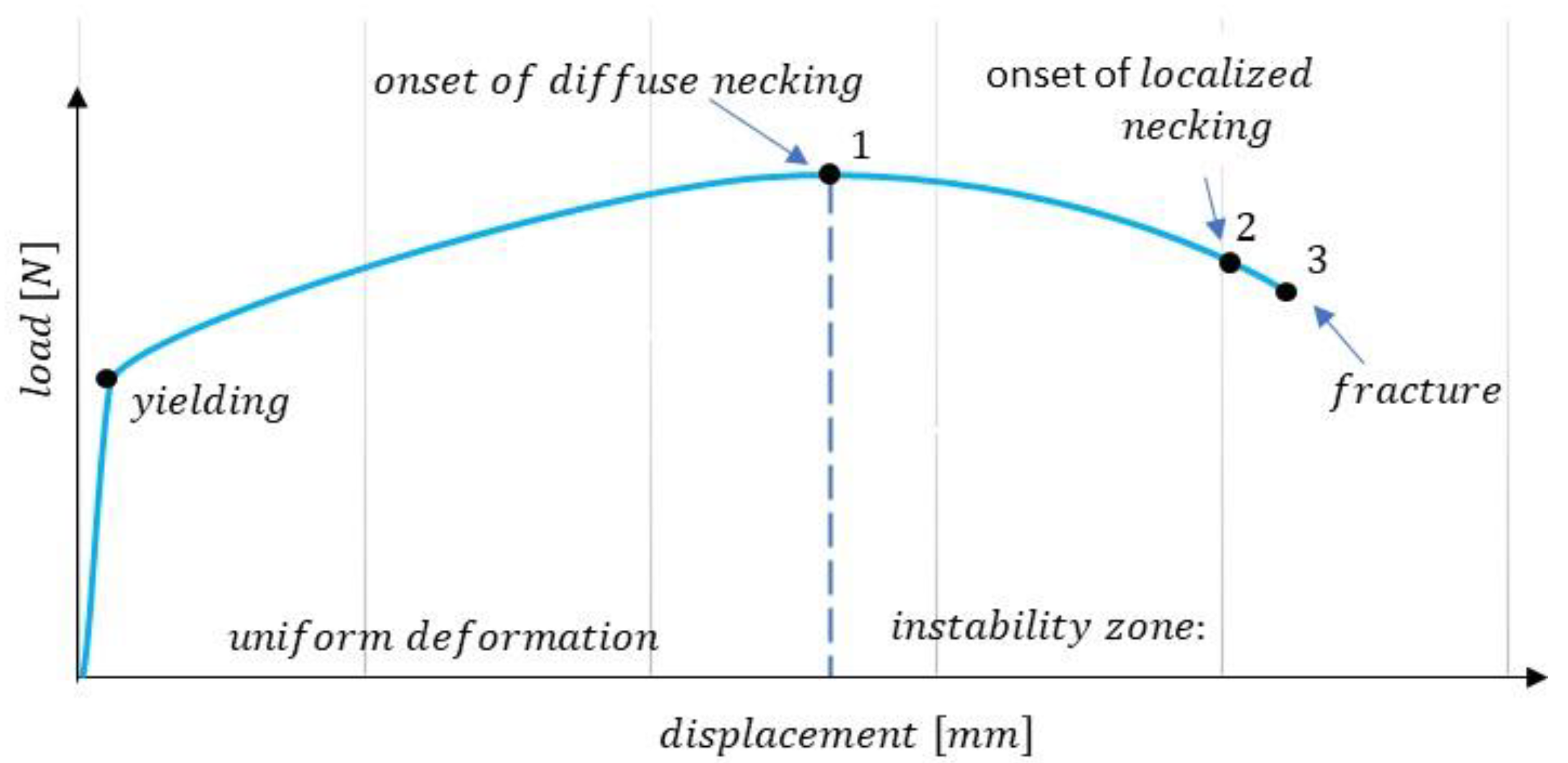
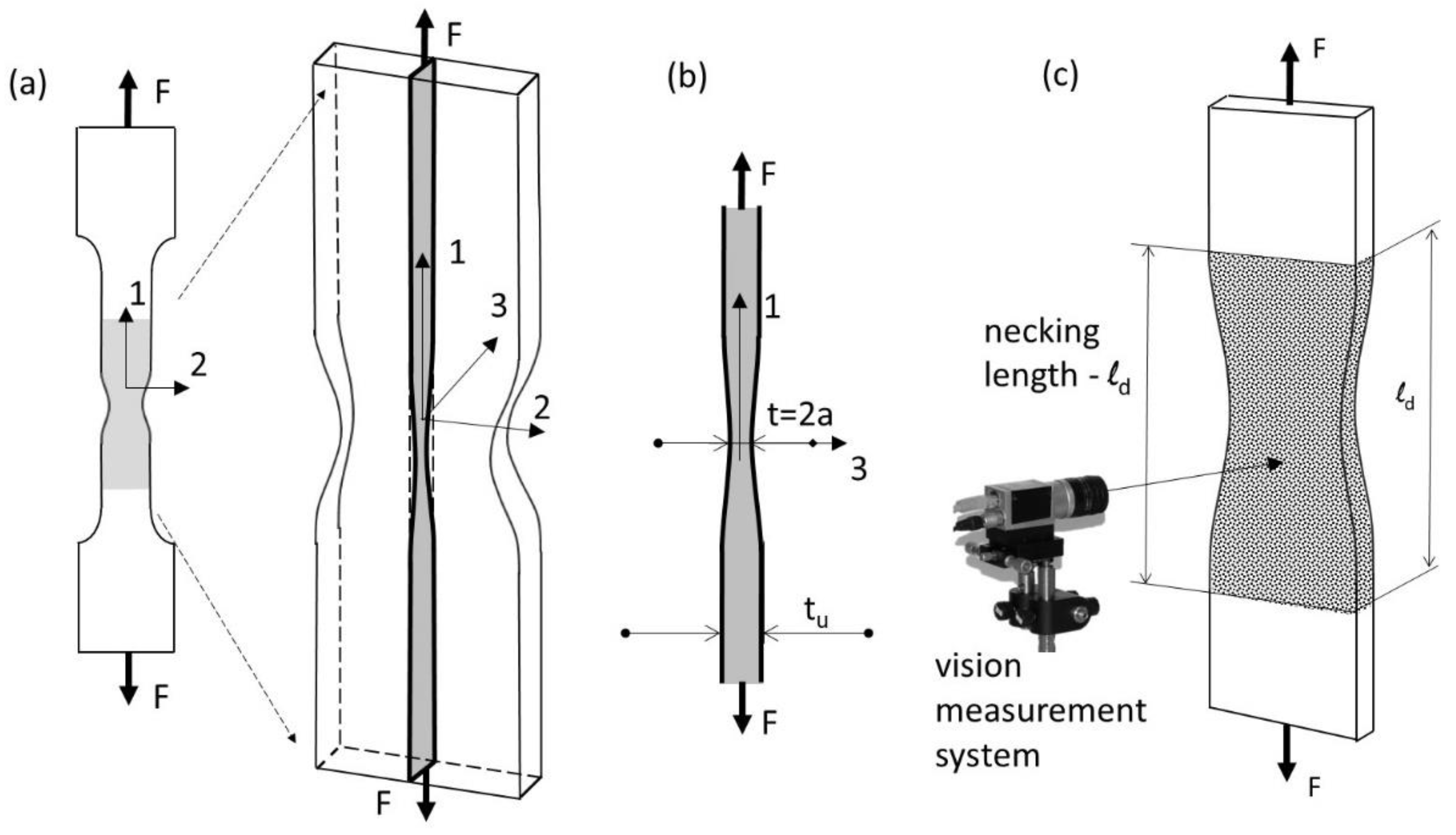
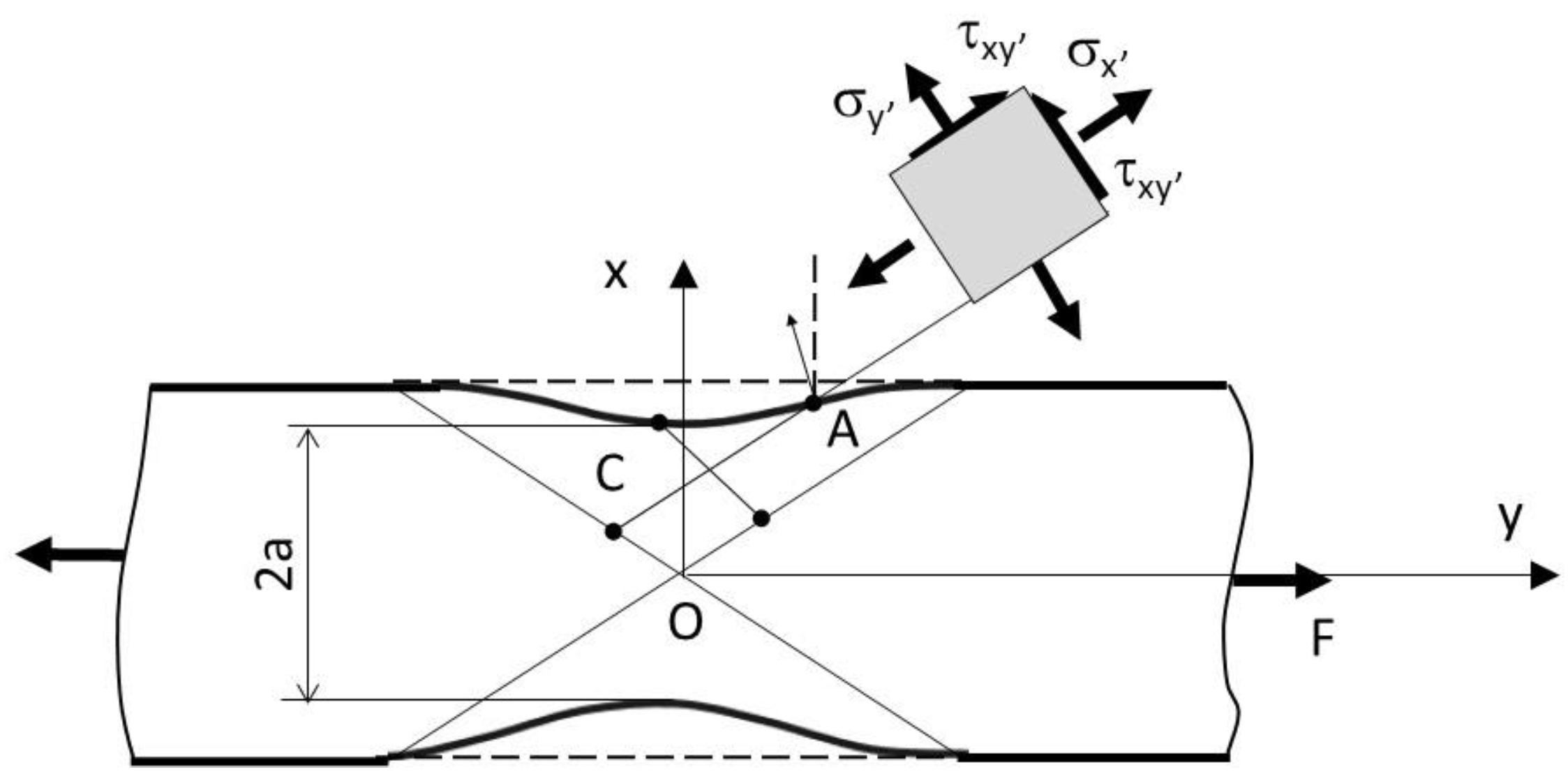

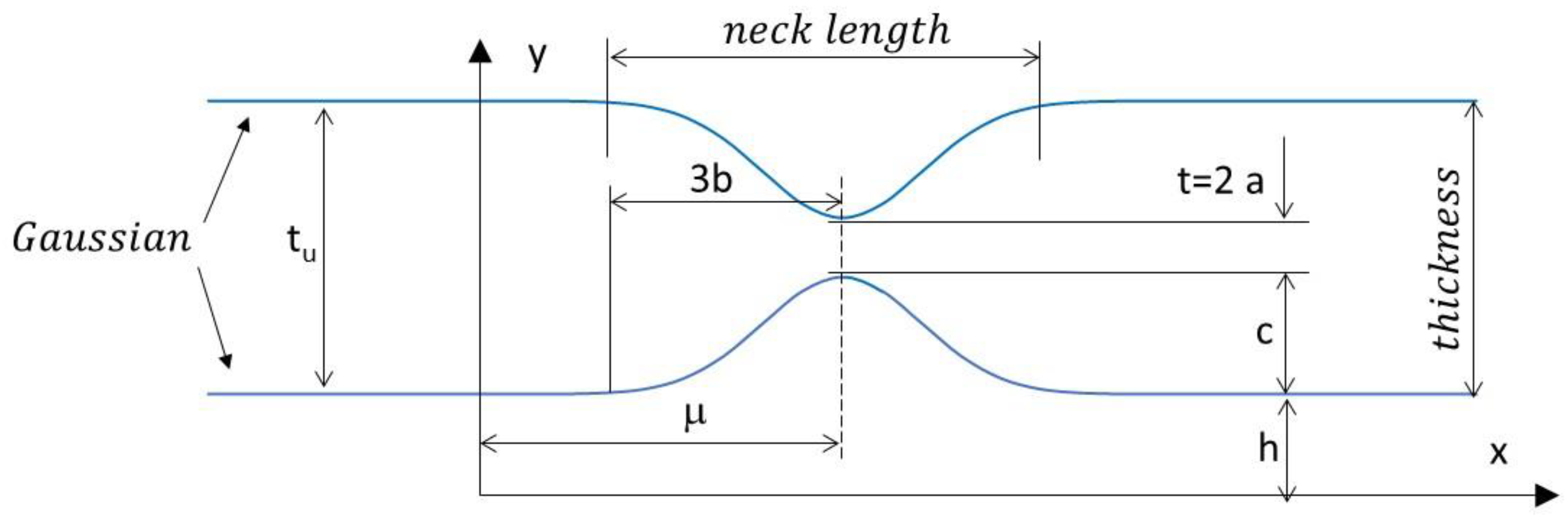
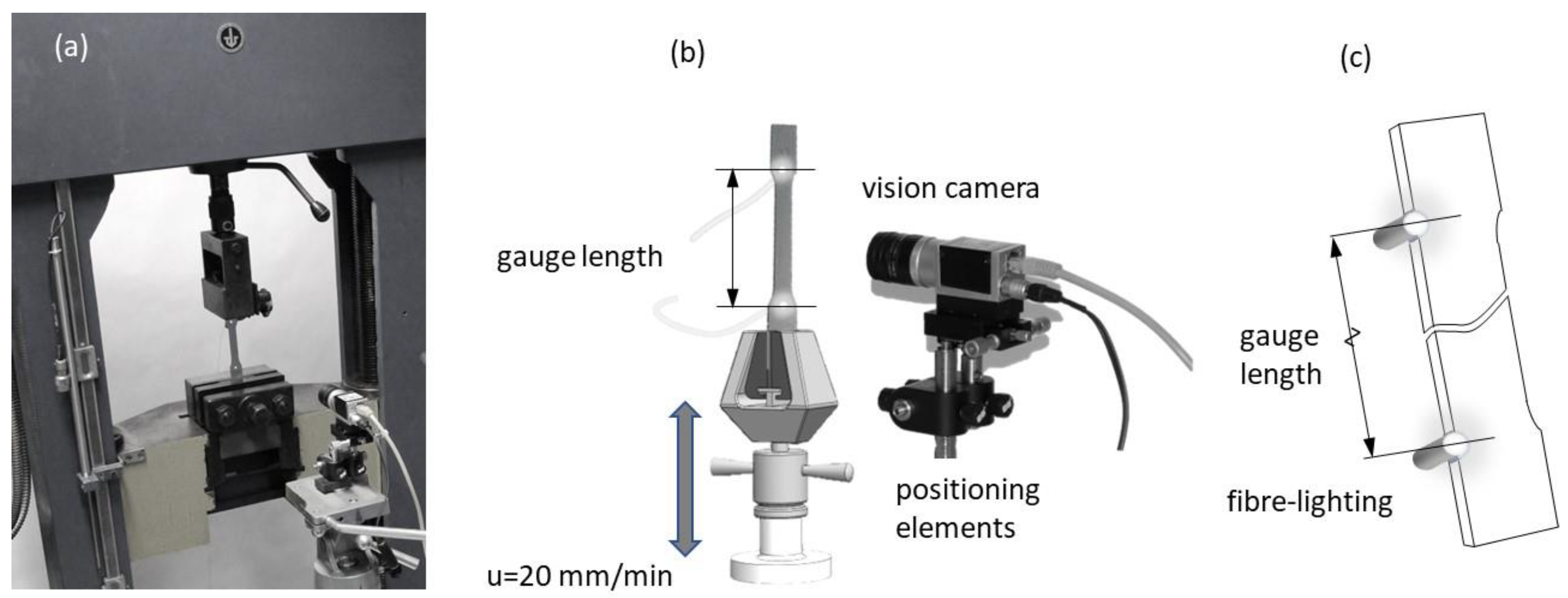

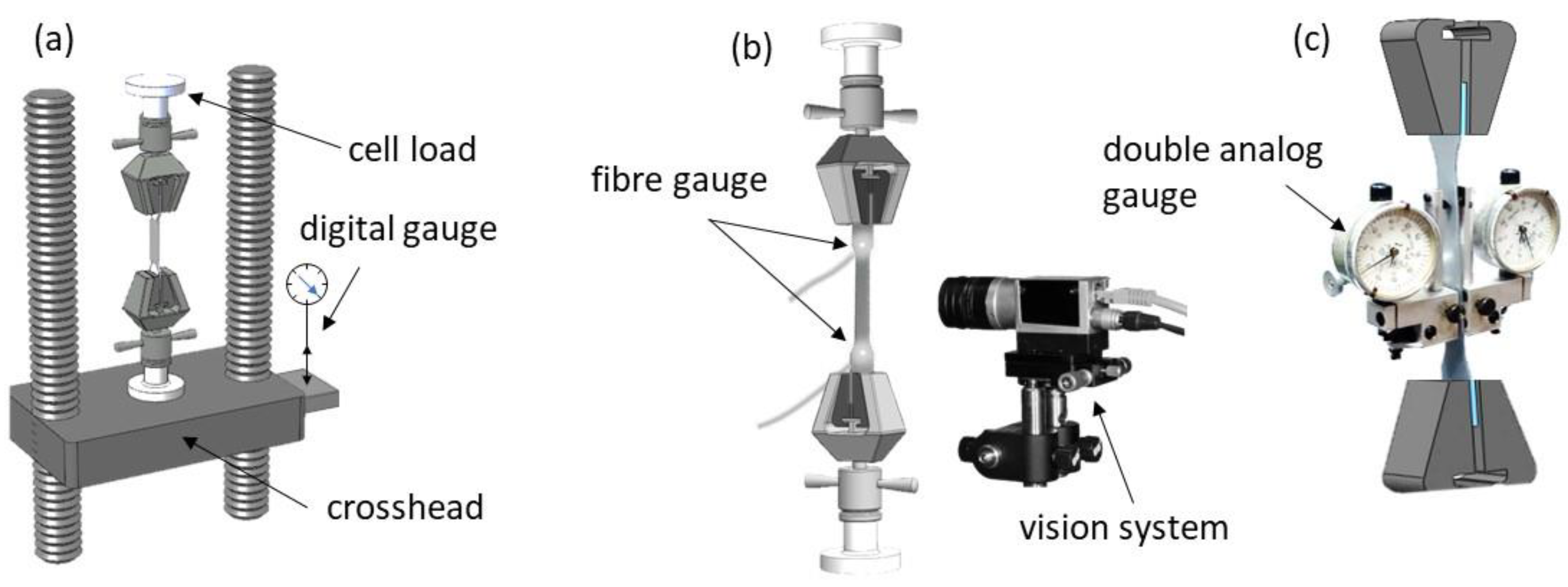

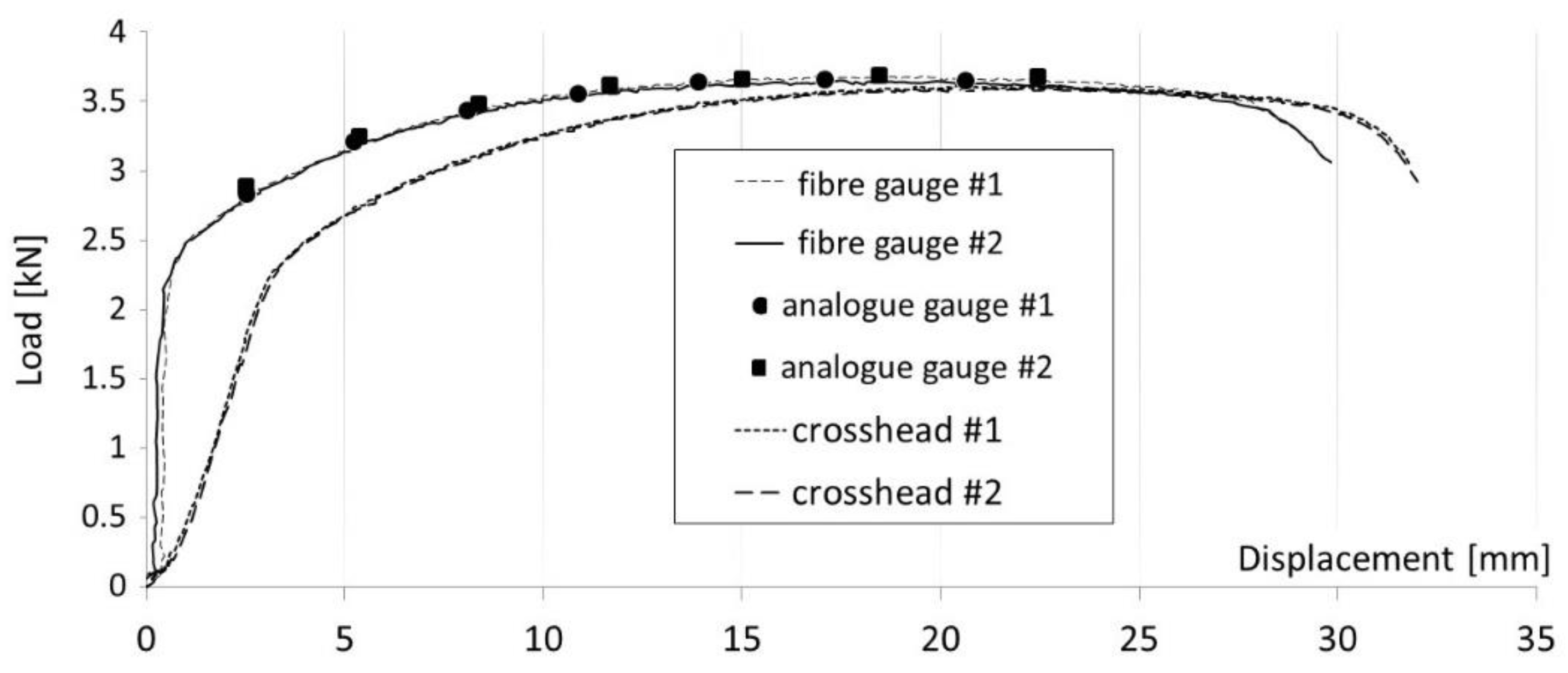

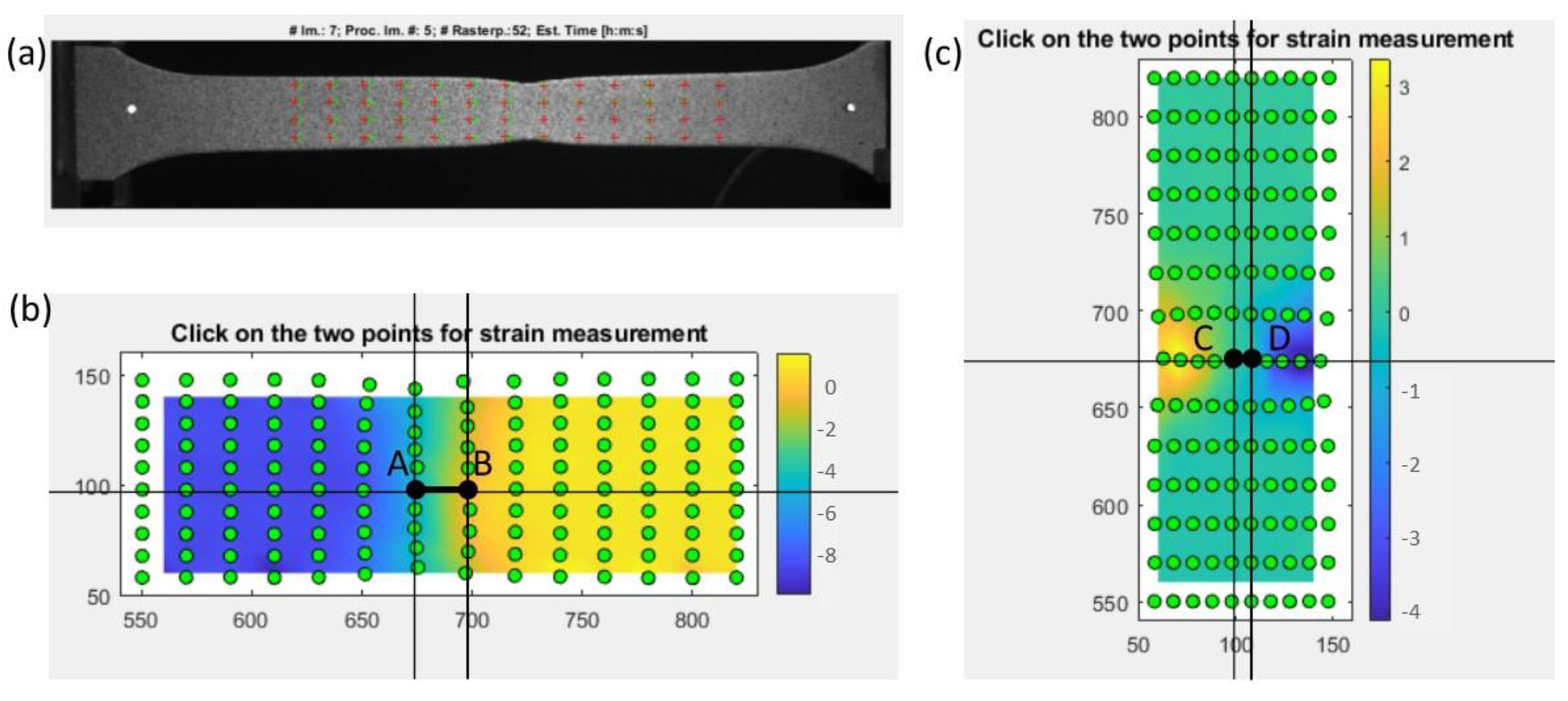
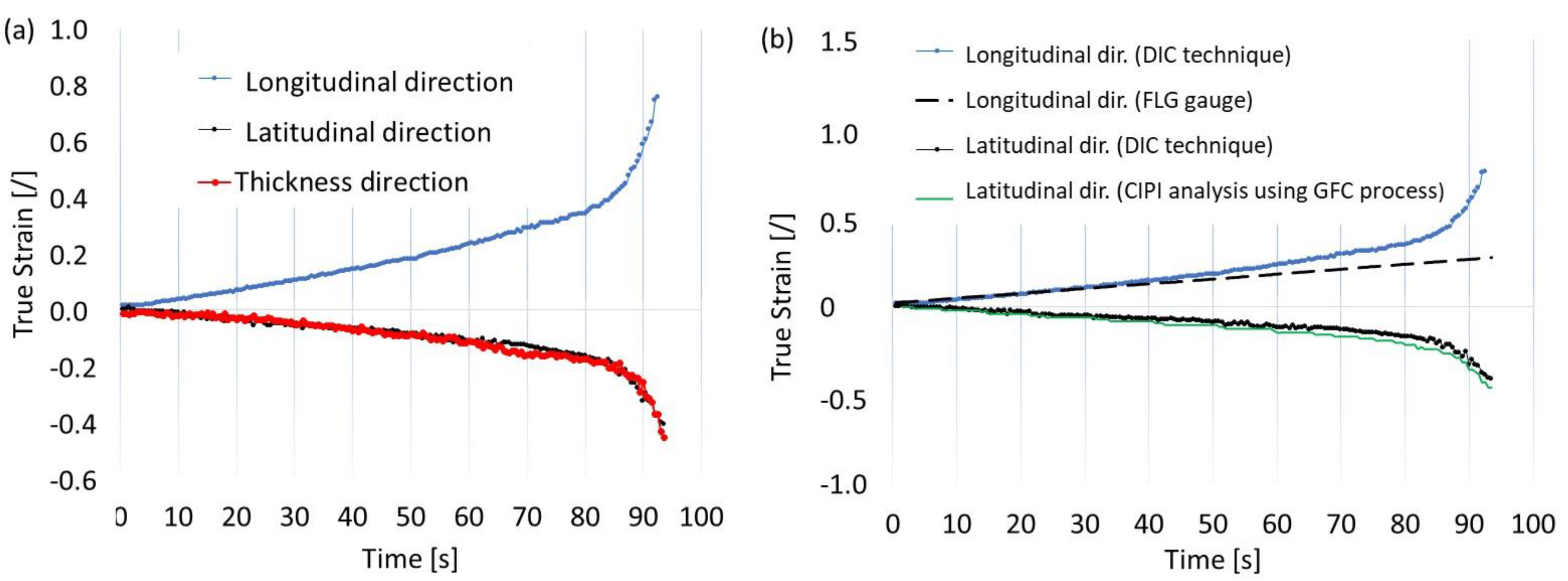
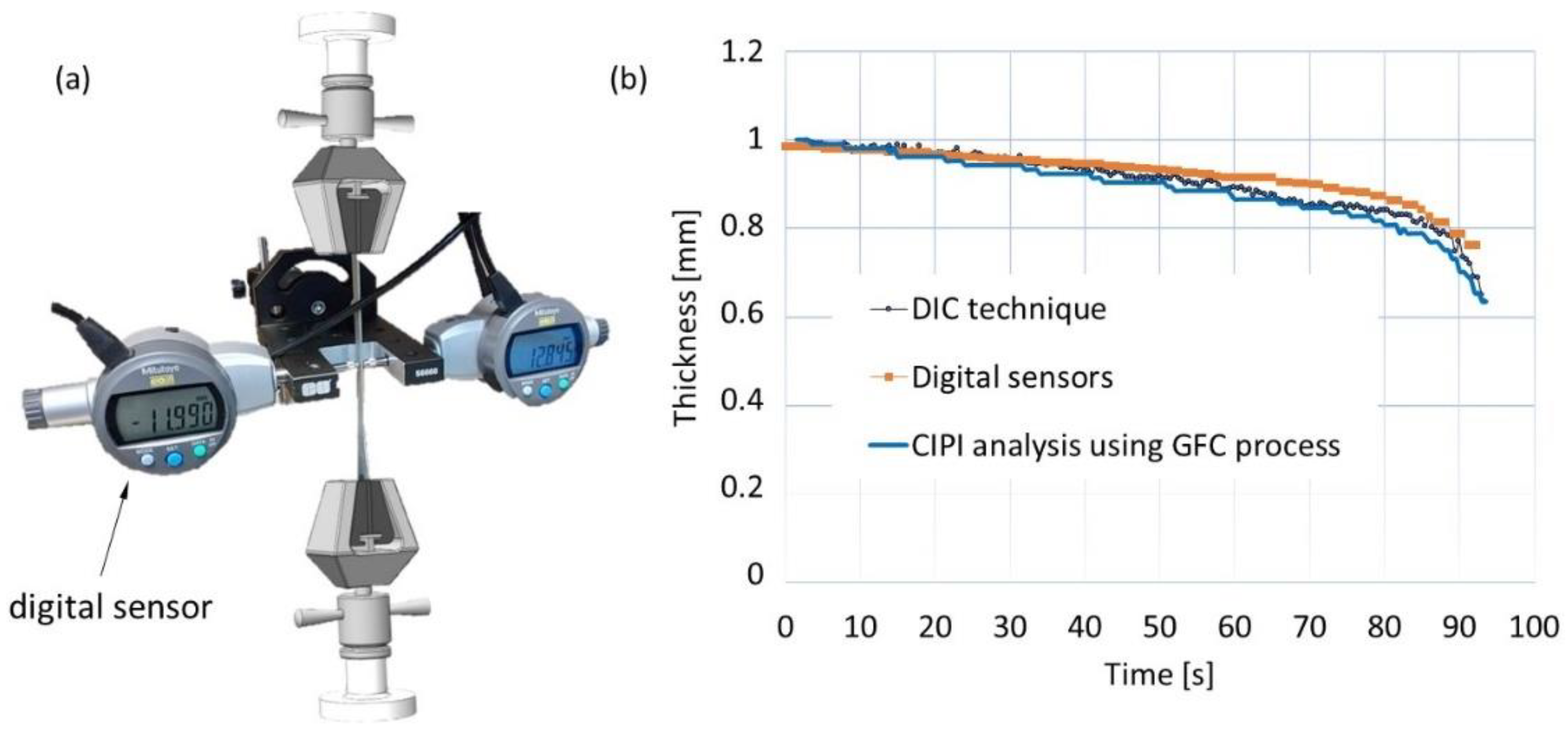

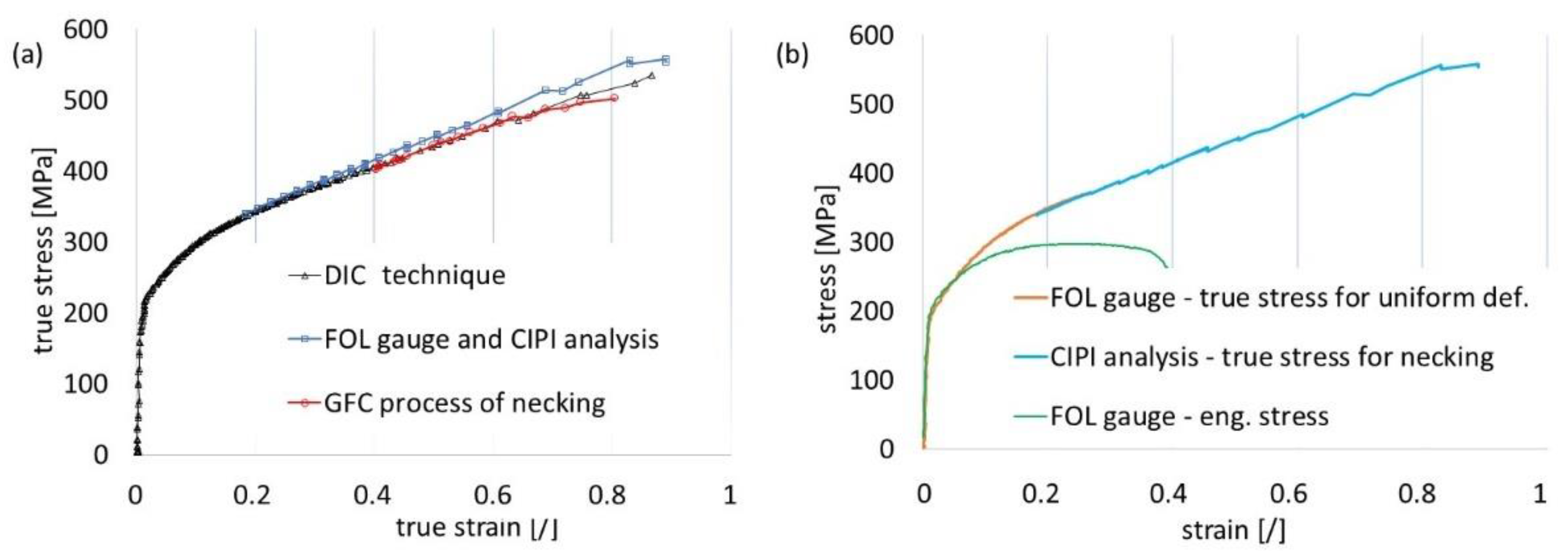

| Material | C [%] | Mn [%] | P [%] | S [%] | F [%] |
|---|---|---|---|---|---|
| DC04 | 0.055 | 0.25 | 0.01 | 0.008 | 99.5 |
Disclaimer/Publisher’s Note: The statements, opinions and data contained in all publications are solely those of the individual author(s) and contributor(s) and not of MDPI and/or the editor(s). MDPI and/or the editor(s) disclaim responsibility for any injury to people or property resulting from any ideas, methods, instructions or products referred to in the content. |
© 2023 by the authors. Licensee MDPI, Basel, Switzerland. This article is an open access article distributed under the terms and conditions of the Creative Commons Attribution (CC BY) license (https://creativecommons.org/licenses/by/4.0/).
Share and Cite
Świłło, S.; Cacko, R. A New Approach for Evaluation True Stress–Strain Curve from Tensile Specimens for DC04 Steel with Vision Measurement in the Post-Necking Phases. Materials 2023, 16, 558. https://doi.org/10.3390/ma16020558
Świłło S, Cacko R. A New Approach for Evaluation True Stress–Strain Curve from Tensile Specimens for DC04 Steel with Vision Measurement in the Post-Necking Phases. Materials. 2023; 16(2):558. https://doi.org/10.3390/ma16020558
Chicago/Turabian StyleŚwiłło, Sławomir, and Robert Cacko. 2023. "A New Approach for Evaluation True Stress–Strain Curve from Tensile Specimens for DC04 Steel with Vision Measurement in the Post-Necking Phases" Materials 16, no. 2: 558. https://doi.org/10.3390/ma16020558
APA StyleŚwiłło, S., & Cacko, R. (2023). A New Approach for Evaluation True Stress–Strain Curve from Tensile Specimens for DC04 Steel with Vision Measurement in the Post-Necking Phases. Materials, 16(2), 558. https://doi.org/10.3390/ma16020558






